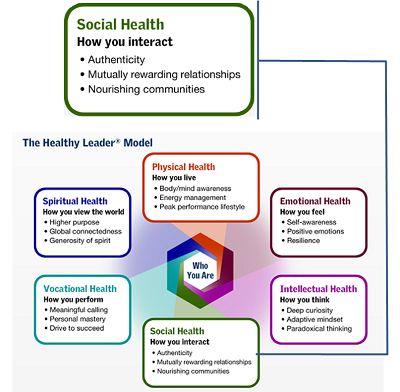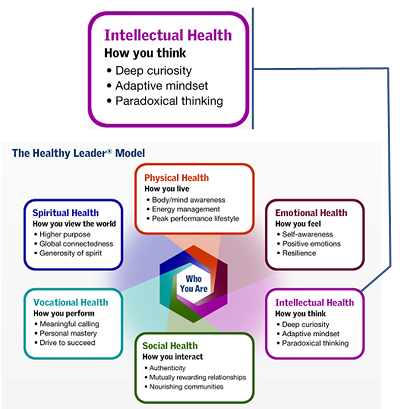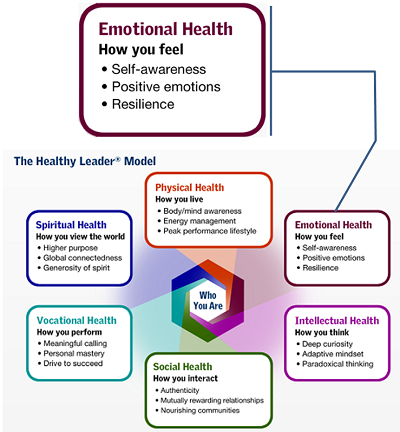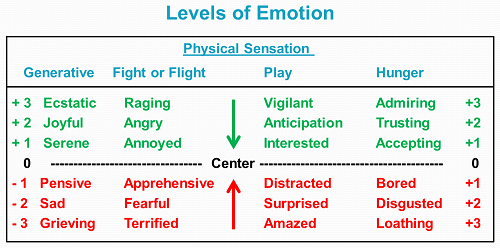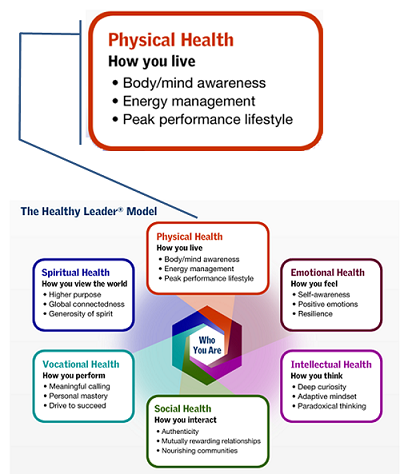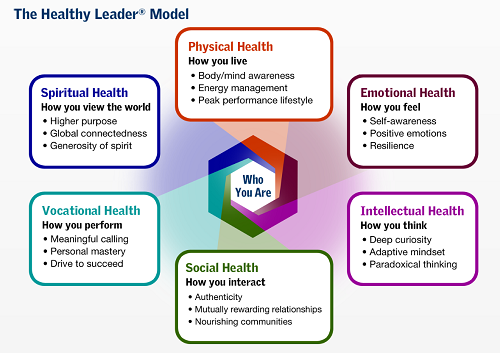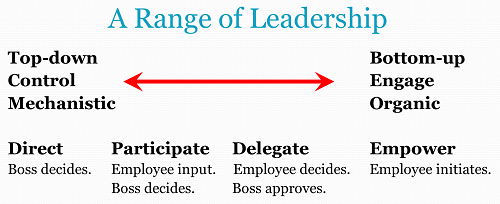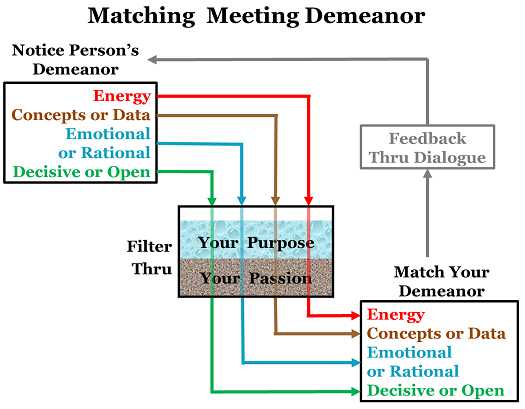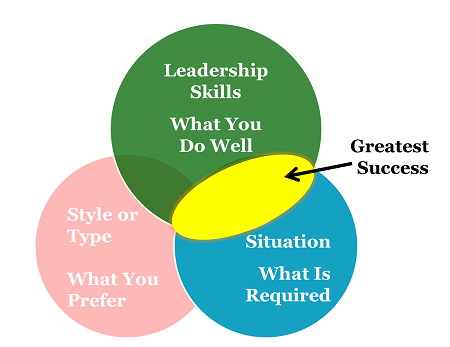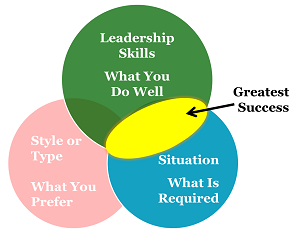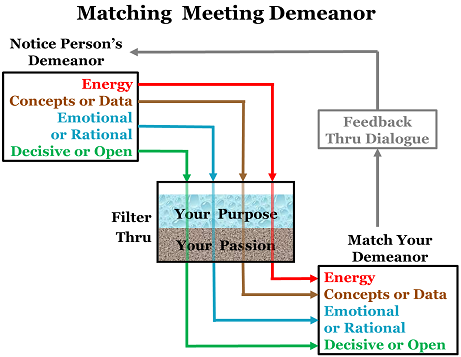When you walk in the room, who shows up for Read more →
The Leader’s Social Health
Allen Slade
Many skills can be put into action without others. We can solve math problems solo. We can read by ourselves. We can create words or visual art alone.
Leadership is not a solo skill. We lead in relationship to others. Our ability to build strong relationships determines our ability to lead. Furthermore, it is not just creating a good first impression that matters. Sustainable leadership requires sustained healthy relationships.
It’s not today’s encounter or today’s sale that matters. It’s all the encounters and the relationships that are going to be fed from today’s sale. If I just care about today’s sale or today’s encounter or today’s exchange, I may make different decisions that affect my whole future. Relationships take a long time to build, and they can be broken very easily.
Atina Diffley Author, public speaker and former organic farmerAs a leader, your health is central to who you are as a leader. In my previous posts on The Healthy Leader® model (created by Bob Rosen of Healthy Companies International), we have considered the leader’s physical, emotional and intellectual health. Healthy leadership also requires social health.
Modified from an image courtesy of Healthy Companies Inc.
Authenticity
Authenticity is being your true self with those you lead. At your best as a leader, you are fully yourself.
Inauthentic leaders rarely set out to deceive. Instead, they compartmentalize or suppress. They may have a work compartment and a home compartment, or they may suppress emotions or thoughts that don’t fit the image they want to project.
Compartmentalizing or suppressing parts of yourself gives off mixed signals. You try to keep value judgments private or hide your annoyance with someone. If you are not a trained actor or a professional poker player, you probably are only partially successful. People may not know specifically what you are hiding, but they are likely to know you are hiding something.
To be authentic, you must be open. Be vulnerable. Let down your defenses. Let others know the real you. It takes courage to open up, but your social health will grow.
Another key to authenticity is consistency. You need to act in similar patterns across time. Your actions should be consistent with your thoughts and emotions. And, your actions need to be consistent with your values and ethics.
Being a better actor is no substitute for authenticity. I worked for a senior executive who launched a new organization. She told a moving story about how she worked with her stepdaughters to pull together as a family. Despite implying domestic happiness, she was separated from her husband and had not seen her stepdaughters for weeks. Yet, she used warm facial expressions, synchronized body movements and perfect tone of voice. Because she was a talented actor, I never totally trusted her again.
When coaching clients ask me how to act differently, I often reply “I don’t give acting lessons.” If you want to act a certain way, you must be that way. If you want to act confident, be confident. If you want act positively, don’t just fake a smile. Notice what is positive in a situation – what is good, true, effective and beautiful. If you want to act as if you are authentic, be transparent and consistent.
Mutually Rewarding Relationships
Healthy relationships are reciprocal relationships. A healthy leader builds relationships that are fair and mutually rewarding. It is not sustainable to treat others as tools to meet your own needs. The socially healthy leader will be quick to help, quick to listen and quick to celebrate the success of others.
Healthy leaders are also open to the perspectives of others. They seek the input of others when making a decision, and they seek feedback about how they are showing up for others.
A healthy leader tends to assume others are acting with positive intent. The leader operates with goodwill, even when there is no “proof” the other person is worthy of being trusted.
Investing in reciprocal relationships tends to pay off. Treating others as trustworthy tends to make you trusted. Seeking input leads to better decisions. Seeking feedback leads to faster growth. Assuming positive motives for others can lead them to grant you goodwill. In other words, mutually rewarding relationships are, well, rewarding.
Nourishing Communities
Humans were created for connections. Couples, families, towns. Sports teams, farmers’ markets, concert audiences. Fire departments, ad agencies, car companies. We come together for good.
As a healthy leader, you do not merely prosper in community. You create healthy communities. You promote collaboration. You identify counterproductive group dynamics and work to improve them. You leverage communities (the power of “&”) to create good, and in doing so, you create joy.
Bottom line: Your social health as a leader flows from authenticity, mutually rewarding relationships and nourishing communities. Your social health invigorates your business success by attracting people to you and your positive vision for the future.
The Leader’s Intellectual Health
Allen Slade
Leadership is all about plugging into the minds and of people. It is about encouraging a spirit of intellectual ferment and constructive dissent so that people are not bound by the status quo, and mavericks are given space and free play.
Kumar Birla Chairman, Aditya Birla GroupAt Slade & Associates, we create dialogue & insight for intelligent change. 
We help our clients be at the top of their mental game. To do so, we have to be at the top of our own mental game.
Being at the top of your mental game requires you to think clearly, critically and creatively in all circumstances. As a leader, intellectual health allows you to make good decisions based on solid insights. Intellectual health is also helps you drive change.
As a leader, it is essential for you to examine your own intellectual health. In the Healthy Leader® model created by Bob Rosen of Healthy Companies International, the leader’s physical health and emotional health are essential. Healthy leadership also requires intellectual health.
Modified from an image courtesy of Healthy Companies Inc.
Deep Curiosity
Intellectual curiosity, at its deepest, reaches outward and inward.
There is an external openness. The leader has a willingness to explore the unknown – seeking new situations, new data and new insights from others. When challenged, the leader wants to explore the differences.
And there is also be an internal openness to new ways of thinking. The leader is willing to challenge her own biases. The leader is willing to approach an issue with alternative perspectives.
Leaders with deep curiosity have the best questions. They go beyond asking about the facts – the who, what or where. They ask how and why. And they actively listen to the answers, curious about what is behind the other person’s thinking.
Are you deeply curious? Do you respond to challenges with openness? Do you ask powerful questions?
Or do you want just the facts? When challenged, do you defend yourself and attack the other person? Do you have more answers than questions?
I encourage you to cultivate your curiosity as a leader and to promote a spirit of inquiry among those you lead. Make extra effort to explore an issue before deciding. And, when someone disagrees with you, see that as a gift.
Adaptive Mindset
Are you intellectually agile? Do you embrace change? Do you constantly reassess your approach? Are you the first to try the new app, take the new class, meet the new person?
Resistance to change is natural, but it can also be intellectually unhealthy. Leaders need openness to change.
Even better, the healthiest leaders initiate change, starting with themselves. Bob Rosen has said “An adaptive mind is a self-transforming mind.”
As the world around us gets more complex, the rate of change is accelerating. You can increase your intellectual adaptability by deliberately embracing the unexpected. You can rewire your thinking so that you lean in to new challenges. You can hold more lightly to your current ways of thinking and acting. Growing your intellectual adaptability increases your leadership range and your managerial effectiveness.
Paradoxical Thinking
Humans often think in dichotomies: Good or bad. Us or them. Go or stop. When we think of people in two groups or cast an issue as right or wrong, we engage in simplistic thinking.
Paradoxical thinking occurs when we hold two conflicting ideas. The healthiest intellects approach a paradox with joy, expecting to be surprised and delighted.
A colleague at Ford Motor Company trained to think paradoxically by repeatedly asking: “So what’s the third alternative?” When faced with high stakes decision that has two choices. What do you do? When faced with a hard choice, a coward equivocates. A decisive leader chooses. A healthy intellect dances on the edge of the paradoxical knife.
Cognitive complexity allows leaders to expand their options. The healthiest intellects don’t boil a decision down to its simplest form. They don’t see people as (all) good or (all) bad. Instead, they keep multiple viewpoints and apparent contradictions in play longer. Paradoxical thinking leads to fewer blind spots, more quickly discarded stereotypes and better decisions. Paradoxical thinking also makes life more fun, because you see the world in color rather than just black and white.
Bottom line: Your intellectual health as a leader flows from deep curiosity, an adaptive mindset and paradoxical thinking. Your intellectual health will help you engage in dialogue and insight so you can lead intelligent change. Your organization will benefit, the people you lead will benefit and you will be prepared for the accelerating pace of change to come.
The Leader’s Emotional Health
Allen Slade
Have you ever worked for a toxic leader? Their very presence sets you on edge. Often, a leader’s lack of emotional health is the source of toxic sewage they spew on others. If your toxic leader had been more self-aware, more positive or more resilient to stress, they might not have triggered fear and loathing.
To guard against becoming a toxic leader, examine your own emotional health. In the Healthy Leader® model created by Bob Rosen of Healthy Companies International, the leader’s physical health is just the starting point. Healthy leadership also requires emotional health.
Modified from an image courtesy of Healthy Companies Inc.
Emotional health is not identical to emotional intelligence. That’s good, because emotional intelligence can be dumb. Emotional health is a better way to think about how our emotions influence our leadership.
Self-Awareness
Are you mindful of your own emotions? You should be aware of your emotional state and know the impact of your emotions on your actions. To help coaching clients become more mindful of their emotions, I suggest three steps:
1. Build a vocabulary of emotions. I like Plutchik’s levels of emotions.
2. Notice your emotions by asking “How am I feeling?” on a regular basis.
3. Reflect on your emotions. How do your emotions serve you? What are your emotional triggers? How do you recover from an emotional hijack?
To be mindful, you also need to be open to feedback. If you see feedback as a problem, you will probably not be as self-aware of your emotions. If you shoot the messenger bearing negative feedback, the messengers will stop coming.
How mindful are you of your emotions? If you need to improve your self-awareness, consider getting a leadership coach or an executive coach to help you notice and manage your emotions.
Positive Emotions
In Georgia, my barber always said farewell with “I appreciate you.” Notice he didn’t appreciate my tip or my business. He appreciated me. Was this just a meaningless habit of a gracious Southern gentleman? I don’t know and I don’t care. It made me feel warm.
Bob Rosen has stated that “Human beings are hardwired for positive emotions. . . . Unhealthy experiences and organizations get in the way of their natural expression.” Americans are pragmatic – we identify problems and drive solutions. As a result, we reward managing negative deviance more than leading with appreciation. A focus on problems can cause you to experience negative emotions most of the time. Since you will project your emotions to the people you lead, you could be the source of toxic sewage.
People don’t enjoy toxic leaders. They enjoy working where they are appreciated. Where the focus is on what is good, true, effective and beautiful. Where problems are secondary to opportunities. Where weaknesses are addressed, but strengths are emphasized.
Do you express positive emotions? How much do you express appreciation for the people around you? How about compassion, love, hope or joy? Do you respond to personal offenses with forgiveness?
Or do you live more on the negative side of emotions? Are you known as a fault finder, a problem solver, a cynic? Do your employees dread meetings with you?
Appreciation comes from the inside. You can rewire your emotions to be more positive. Once again, a good leadership coach can help. So can the right barber.
Resilience
When times are tough, resilient leaders are worth their weight in gold. Your ability to lead in storm weather is based in part on your emotional resilience. A resilient leader buffers stress for others.
Emotional resilience is based in part on your ability to get to the center of an emotional storm. 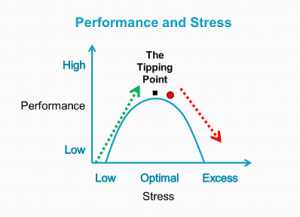 Resilient leaders avoid passing their tipping point of performance, and they manage their own stress to avoid crashing and burning. They know how to create just enough anxiety to drive innovation and change without creating panic.
Resilient leaders avoid passing their tipping point of performance, and they manage their own stress to avoid crashing and burning. They know how to create just enough anxiety to drive innovation and change without creating panic.
How resilient are you? Do you bounce back quickly from setbacks? Are you confident in managing the ups and downs of your organization? Do your employees see you as a stress buffer who helps them through the storm?
Or do setbacks drag you down? Is your confidence only as good as your most recent success or failure? Do your employees see you as a stress amplifier who adds to the drama?
My advice for becoming more resilient is simple, but difficult: Be strong and courageous. There is no easy way to be the leader you should be.
Bottom line: Your emotional health as a leader is based on your self-awareness, your positive emotions and your resilience. How are you doing?
The Leader’s Physical Health
Allen Slade
I think of my time as CEO as more of a marathon than a sprint. So, I’ve really been focused on how do I live healthy enough so that I can stay in this high level of energy for a long period of time. I’ve been dieting. I’ve been working out more. I’m 53. I still theoretically have 12 years to go [until retirement].
John Schlifske Chairman and CEO Northwestern MutualLeadership is like a tree. The leader’s accomplishments are the fruits of leadership. The leader’s actions are the visible parts of the tree – the trunk, branches and leaves. But the roots of healthy leadership are defined by who the leader is. Without healthy roots, there will be no fruit and the tree will wither.
In the NFL combine, high potential athletes are asked to run, jump and lift weights to assess their potential to succeed in professional football. To succeed as a leader, you don’t need to max out your 40 yard dash or vertical leap. Instead, leaders need to be energetic, hardy and have the physical capacity to put out the extra effort needed to succeed. In the Healthy Leader® model created by Bob Rosen of Healthy Companies International, the leader’s physical health is the starting point.
Modified from an image courtesy of Healthy Companies Inc.
Let’s consider each of the three aspects of physical health.
Body/Mind Awareness
To be a healthy leader, you need to understand the link between your physical well-being and your thoughts and emotions. You need to make healthy choices and take actions to manage stress and address illness. You also need to enable your team to have a healthy lifestyle, including adjusting work demands that are causing health issues.
Some leaders are naturally attuned to their bodies and have healthy habits. Others, including me, need to be more deliberate. I don’t exercise out of habit, so I look for external motivation. Right now, I am training for a century – a 100 mile bike ride – because the event gives me a goal that motivates me to work out. If you are driven by your schedule, you may benefit from scheduling time for your health. Other people may be motivated by having an exercise partner or trainer.
Where are you as a leader on Body/Mind Awareness? Do you habitually make healthy choices? If not, create a plan to get yourself heading in the right direction.
Energy Management
Jim Clawson says effective leadership is “managing energy, first in yourself, then in those around you.” In some ways, our capacity to do work is like a battery. Some things drain our energy and other things charge us up. Working long and hard drains us, and rest restores our energy. There are key differences among leaders. Extraverts gain energy from social interactions while introverts are drained by meetings and parties. When facing a day of solitary work, introverts can gain energy as the day goes on, while extraverts need to get out and chat to keep their energy level high.
How effective are you at managing your own energy? When your batteries are running low, can you recharge yourself? I sometimes advise coaching clients in high stress jobs “Go fast to go slow, and go slow to go fast.” In other words, slowing down to recharge yourself can reduce errors and rework.
Managing your own energy is only half the game. You must also manage energy in those around you. In times of stress, some leaders act as stress buffers, providing encouragement and practical help when the impossible deadline is looming. Other leaders add stress by micromanaging and projecting their own fear of failure onto their team. A healthy leader is aware of the energy level of others and takes steps to keep the team’s energy up.
How good are you at managing your own energy? How good are you at managing energy in others? If you need to get better at energy management, the first step is simple: Be mindful of energy levels in yourself and others. Notice what adds energy and what depletes energy. As you notice energy more, you will be able to manage energy better.
Peak Performance Lifestyle
Even a fully charged AA battery will not be able to power your kitchen stove. If energy management is about charging up depleted batteries, peak performance lifestyle is about increasing the size of the batteries. The healthy leader is able to manage stress at home and work, get plenty of sleep and make healthy choices to lead for the long haul. The healthy leader also helps team members have a healthy work-life balance.
Some organizations value employee health, and they provide programs – fitness centers, flexible work arrangements, healthy food at work locations – that support healthy lifestyles. Other organizations see employee health as a cost and do the minimum required by law or the labor market. It can be shorted-sighted to deplete your employees’ health to gain short term performance at minimum cost. As an individual leader, don’t be boxed in by your organization’s lack of support for a peak performance lifestyle. You need to strive for your own peak performance. You also need to takes steps to help your team be healthy and perform well.
Bottom line: As a healthy leader, you need to support the physical health of those you lead. To do that, you need to be aware of your own physical health, manage your energy and strive for a peak performance lifestyle.
The Roots of Healthy Leadership
Allen Slade
For sustained leadership success, you must consider more than just what you accomplish or how you act. You must consider who you are.
Bob Rosen of Healthy Companies International has been researching and writing about leadership health. He has a book coming out soon and because of the partnership between Healthy Companies and Slade & Associates, I would like to give you a sneak peak of Bob’s Healthy Leader® model. Today’s post will share some images of healthy leadership, and over the next month, we will explore the impact of healthy leadership on organizations
Leadership is like a tree. The leader’s accomplishments are the fruits of leadership. The leader’s actions are the visible parts of the tree – the trunk, branches and leaves. But the roots of leadership are defined by who the leader is. Without healthy roots, there will be no fruit and the tree will wither.
The six dimensions of leadership health – physical, emotional, intellectual, social, vocational and spiritual – define who you are as a leader. They are the roots of your leadership.
Image courtesy of Healthy Companies Inc.
Leaders who are healthy have strong roots that lead to effective leadership behavior and positive outcomes for the organization.
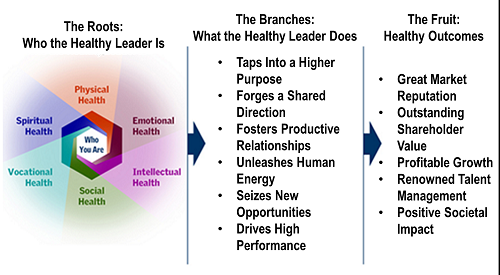 Modified from an image courtesy of Healthy Companies Inc.
Modified from an image courtesy of Healthy Companies Inc.
How healthy is your leadership? By examining the roots of your leadership, by looking at who you are and not just what you do or how much you accomplish, you can create sustainable success for yourself and those you lead.
Images of the Leader’s Toolbox
Allen Slade
When I joined Ford in 1990, I sketched out an approach to leadership development called the manager’s toolbox. Words did not capture my vision, so I created a rough line drawing of a toolbox. Over the next two decades, I changed the name to the leader’s toolbox and used it with MBA classes, consulting contracts and coaching clients. In my recent posts, I used images to bring the leader’s toolbox alive.
Today’s post pulls all those images together. I invite you to examine your leadership by looking into the leader’s toolbox.
Leading on Cruise Control
The best leaders are versatile. They adjust their leadership to the needs of the moment. They are inconsistent in order to gain consistently great results.
The Leaders Toolbox
What’s in your leader’s toolbox? Don’t try to lead with duct tape and a pair of vice grips.
 Get the tools to do the job right:
Get the tools to do the job right:
Task and Person Leadership
Communication
Decision Making
Fast, Decisive Action and Slow, Deliberate Contemplation
Verbal, Quantitative and Emotional Intelligence
Using the Tools of Leadership
 Know the right leadership tool for your situation.
Know the right leadership tool for your situation.
Combine appropriate risk-taking, feedback and reflection with the wisdom of a leadership coach.
Leadership Tools: Confidence
Treat confidence like a tool rather than a trait. Match your confidence to the situation to maxmize your credibility and influence.
Leadership Tools: Matching Meeting Demeanor
Effective leaders are versatile in their meeting demeanor. They are high energy or calm. They use concepts or data, feelings or logic, decisiveness or patience, as the situation demands.
Leadership Tools: Purpose & Passion, Feedback & Subtlety
To maximize meeting impact, filter your actions through your purpose and passion. Get instant feedback. And match demeanor, don’t just mimic behavior.
Styles & Types? Or Situations & Tools?
Leaders cannot rest on a certain style or type. Fill your toolbox with leadership skills and be flexible in when you use which tool.
Bottom line: Fill your toolbox with a wide range of leadership skills and be flexible in when you use which tool. You will increase the sweet spot of your leadership and reach your greatest success as a leader.
Styles & Types? Or Situations & Tools?
Allen Slade
In my experience, the leader’s toolbox is a powerful way to think about your leadership. But some people push back, especially fans of leadership styles or personality types.
Styles and Types
Some leadership advice focuses on changing leaders to be the right style. Be more participative or be more communicative. Be a Theory Y leader. Be a 9,9 leader. Unless you luck into the right situation where this style is always best, one-best-style leadership advice should be avoided.
A somewhat better form of leadership advice is to “find your leadership style” so you understand how you work best. A strategic leader might want to complete and complement her leadership style by hiring a detail oriented manager. Closely related is “find your type” advice using a personality test or the Myers Briggs Type Indicator. If you know your personality type, then you can find situations that fit your personality. Introverts can work on solo analytical projects, while extraverts should find jobs with lots of personal contact.
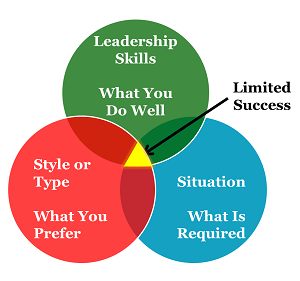 Taken to the extreme, “find your style” or “find your type” leadership limits your success as a leader. Your sweet spot as a leader will be the narrow intersection of skill, style and situation. If your style limits your range of leadership, your success will also be limited.
Taken to the extreme, “find your style” or “find your type” leadership limits your success as a leader. Your sweet spot as a leader will be the narrow intersection of skill, style and situation. If your style limits your range of leadership, your success will also be limited.
Restricting yourself to one preferred leadership style or personality type is like restricting your driving to only certain roads. If you can drive on more roads, you will go further.
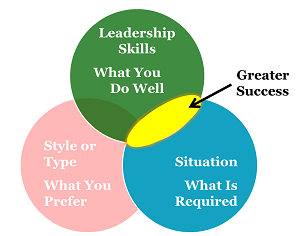 If you take your prefered leadership style or personality type out of the picture, you expand your sweet spot. You can lead in more ways and you will have greater success as a leader.
If you take your prefered leadership style or personality type out of the picture, you expand your sweet spot. You can lead in more ways and you will have greater success as a leader.
For example, my personality is strongly introverted. Yet, to be successful as a consultant, an HR executive and a professor, I stopped acting like an introvert. I developed my public speaking skills. I focused on networking even when I wanted to curl up with a good book. I don’t use my personality as an excuse. If my leadership does not serve me well in a given situation, I try another harder or switch leadership tools.
Situations and Tools
The leader’s toolbox approach expands your choices as a leader:
1. Fill your toolbox with a variety of leadership tools for relationships (communication skills, meeting demeanor, decision making techniques, confidence and emotional intelligence) and tasks (budgeting, scheduling, goal setting, execution and quantitative skills).
2. Pick out the right tool for the situation.
3. Get feedback and adjust as necessary.
Bottom line: To be fully effective as a leader, you must be flexible in your own behavior. A lack of adaptability fundamentally limits you as a leader. You cannot rest on a certain leadership style or preferred type of interaction. You should fill your toolbox with a wide range of leadership skills and be flexible in when you use which tool. You will increase the sweet spot of your leadership and reach your greatest success as a leader.
Leadership Tools: Purpose and Passion, Feedback and Subtlety
Allen Slade
The most effective leaders adapt to the situation, but they are driven by their own purpose and passion. You can stumble by being inflexible. You can stumble if circumstances drive you. The best leader will balance openness to feedback with constancy of purpose.
How do you balance adaptability with purpose and passion? One example is the leadership tool of matching meeting demeanor.
As you match the four aspects of meeting demeanor (energy, concepts or data, emotional or rational persuasion, decisive or open-ended), you need purpose and passion, feedback and subtlety.
Purpose and Passion
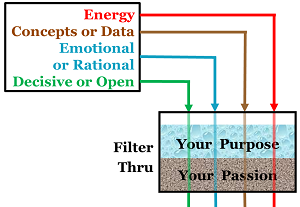 As a leader, your purpose sets your direction. Your passion energizes your actions. Your purpose and passion should filter everything you do, including your meeting demeanor.
As a leader, your purpose sets your direction. Your passion energizes your actions. Your purpose and passion should filter everything you do, including your meeting demeanor.
In a meeting at Microsoft, a vice president, my boss and I were synced up on meeting demeanor. We had medium energy and we were looking at concepts, rationally and decisively. Then, we discussed “what would happen if” we were asked to violate employee confidentiality. Because of my passion for confidentiality, I immediately switched demeanor. I went high energy and made an emotional argument. In other words, I threatened to quit. The meeting quickly broke up, my boss high-tailed it down the hall and I was left standing outside the VP’s office.
The VP apologized the next morning, and I was never asked to compromise my standards. But, even if I had lost my job over this outburst, my passion for confidentiality is so strong that I would have been content with my actions.
Feedback
Leaders have to balance constancy of purpose with openness to feedback. To be effective, you need feedback on your impact.
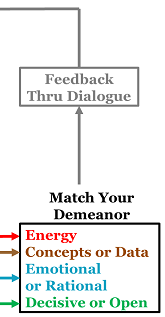 If you have no awareness of others’ meeting demeanor, you will usually not be very effective. If you take a quick snapshot of energy, data vs. concepts etc., at the beginning of the meeting, you will be more effective.
If you have no awareness of others’ meeting demeanor, you will usually not be very effective. If you take a quick snapshot of energy, data vs. concepts etc., at the beginning of the meeting, you will be more effective.
But, just like video is richer than still photos, you want to have continuous feedback on your meeting impact. Watch their body language, voice tone, and what they say to see if you are truly matching up your demeanor.
Match, Don’t Mimic
The wise leader will adjust meeting demeanor directionally to fit the demeanor of others, but not to excess. I suggest matching at a level of 80% to 120%.
- If the other person has much higher energy than you, adjust your energy to 80% of theirs. If they are much lower energy, adjust your energy to 120% of their energy.
- If they are all about concepts, don’t skip the data slides in your presentation. Just touch them lightly and move on.
- If they are absolutely decisive, match their drive to decide, but reserve the right to request a future meeting to follow up on the issue. If you request followup decisively, they are likely to say yes.
Bottom line: Your impact is magnified by matching the meeting demeanor of others in the room. Filter your actions through your purpose and passion. Get instant feedback by observing how your demeanor is impacting the others. And be subtle – match demeanor, don’t just mimic behavior. Then, your meeting influence will grow as the people around you respect your adaptable leadership.
Leadership Tools: Matching Meeting Demeanor
Allen Slade
Leaders need a toolbox full of tools for task leadership (budgeting, scheduling, goal setting, task execution) and relationship building(communication, decision making techniques, empathy). To use these leadership tools well, you need to diagnose the situation before you pick your tool.
A coaching client asked me “How should I act?” in an important meeting. I suggested matching his confidence to his competence and matching his demeanor to the other person. Let’s look at how “demeanor matching” works.
Often, leaders are called upon to persuade someone to take action. You might be planning with your boss, problem solving with an employee, trying to close a sale or interviewing for a job. It’s important to focus on the content of the meeting, but your influence will be determined by the tone of the meeting. How do you get your demeanor right?
Consider four dimension of meeting demeanor:
- High energy vs. low energy.
- Concrete data vs. abstract concepts.
- Rational persuasion vs. emotional persuasion.
- Decisive choices vs. option multiplying.
If two people are badly mismatched on any of these dimensions, the meeting will not go well.
We have all been held hostage in meetings. The other person is not on your wavelength and they are clueless about their lack of influence. They are high energy while you are drifting off. Maybe they offer abstract concepts when you need hard data. Or they make an emotional appeal when you want a rational argument. They push for decisive action when you want to keep your options open.
To avoid holding others hostage in a pointless meeting, don’t be tone deaf. Start by noticing the other person’s demeanor, then decide how your meeting demeanor needs to adjust.
Energy. If they have little energy for this topic, don’t try to bulldoze them. Take a low key approach. Pause, contemplate, listen even more than usual. But if they have high energy, ramp up your excitement to match.
If your purpose is to pursuade them, you may have to go against your native personality. Extroverts may have to calm down. Introverts may need to get fired up.
Concepts/data. If their conversation centers around concepts, principles, precedents, fairness – respond in kind. If they ask for data, proof, evidence, case studies, give them the numbers and facts they need.
Once again, you may be more conceptual or more data oriented, but don’t let that undermine your effectiveness if the other person is on a different wavelength.
Emotional arguments or rational arguments. Listen and observe. If they say or act in a way that suggests they want to approach this topic through an emotional lens, paint your argument with the colors of feeling. If they want to argue, respond with logic.
The “emotional intelligence” industry is built on the failings of leaders who think it is irrational to be emotional. You can also fail with feelings when the other person wants logic. Either way, if your purpose is to persuade, you may have to step outside your native logic to match their meeting demeanor.
Decisive or open. Sometimes, the other person wants to decide now. Other times, they want more options, more evidence or more people involved.
If you are naturally decisive but they want more time, you may need to practice patience. If you tend to keep your options open but the other person expresses impatience, you may need to work toward a “best guess” decision.
Bottom line: Effective leaders are versatile in their meeting demeanor. They use high energy or calmness, concepts or data, feelings or logic, decisiveness or patience, as needed to fulfill their purpose in the meeting.
In your next meeting, try noticing the demeanor of the other person. Then notice your own demeanor. Adjust as needed to be at your most influential.
Leadership Tools: Confidence
Allen Slade
Effective leadership requires adaptability. Leaders should fill their leadership toolbox and then pick the right tool for the situation. In other words, match your behavior to the task at hand.
Last week, a coaching client preparing for a one-on-one meeting asked “How should I act?” Because principles of leadership are outdated, I didn’t give a one-size fits all answer. Instead, I suggested two ways to match his behavior to the situation: Match your confidence to your competence (today’s topic). Your demeanor should match the other person’s demeanor (in the next post).
As a leader, your confidence is a tool. You should be able to influence others based on your experience, your expertise or your position of authority. But like any tool, you can misuse your confidence.
Overconfidence is a common leadership failing. If you choose to act confident, make sure you have the competence to back it up. If all you own is a hammer, everything looks like a nail. If your leadership “style” is always high confidence, you will hammer decisions and people. Don’t be that leader.
Lack of confidence is another leadership failing. If you act like you do not know, you will undermine your leadership. If you don’t act like a confident leader, no one will want to follow you.
Even moderate confidence has drawbacks. “Powerful but approachable” or “humble yet decisive” may be desirable blends, but there are times when very high confidence (or very high humility) would be better than a compromise.
Sticking with one level of confidence – high, low or in between – would be leading on cruise control. Instead, match your confidence to your competence.
Suppose you face a high stakes technical decision. How can you match your confidence to your competence?
If you are a novice in the technology, listen and learn. Ironically, you can build credibility by complying with others. Save your confidence for situations where you know what you are talking about.
If you know about as much as the others in the room, engage in a good give and take. Bring your competence to bear, but don’t be overbearing. Admit the limits of your expertise and experience. Value the competence of others.
If you are highly competent to deal with this issue, you can show analytical strength and make hard-hitting recommendations. But even as the most competent person in the room, treat your confidence as a tool rather than a trait. At times, put confidence back in the toolbox to pull out other tools like listening or consensus building.
Bottom line: Treat confidence like a tool rather than a trait. Match your confidence to the situation to maxmize your credibility and influence.








